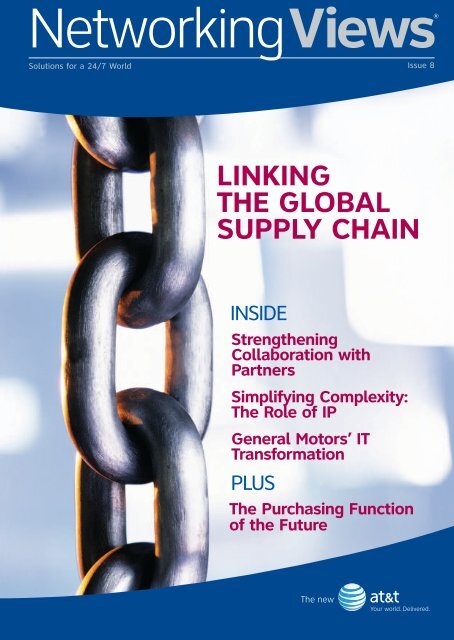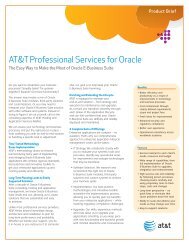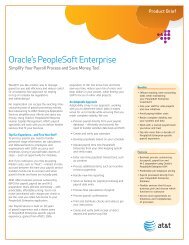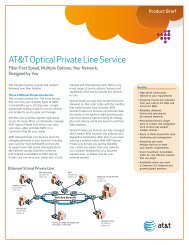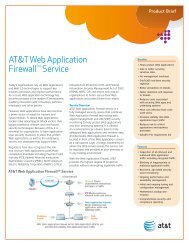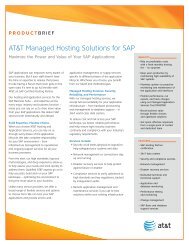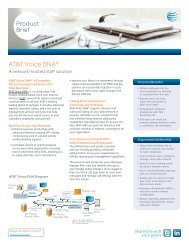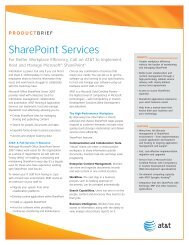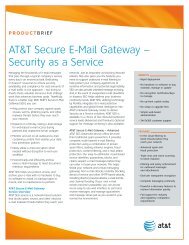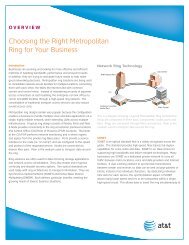LINKING THE GLOBAL SUPPLY CHAIN - Enterprise Business - AT&T
LINKING THE GLOBAL SUPPLY CHAIN - Enterprise Business - AT&T
LINKING THE GLOBAL SUPPLY CHAIN - Enterprise Business - AT&T
You also want an ePaper? Increase the reach of your titles
YUMPU automatically turns print PDFs into web optimized ePapers that Google loves.
NetworkingViews®<br />
Solutions for a 24/7 World Issue 8<br />
<strong>LINKING</strong><br />
<strong>THE</strong> <strong>GLOBAL</strong><br />
<strong>SUPPLY</strong> <strong>CHAIN</strong><br />
INSIDE<br />
Strengthening<br />
Collaboration with<br />
Partners<br />
Simplifying Complexity:<br />
The Role of IP<br />
General Motors’ IT<br />
Transformation<br />
PLUS<br />
The Purchasing Function<br />
of the Future
IN THIS ISSUE<br />
Increasingly, businesses are viewing convergence<br />
as critically important in achieving their strategic<br />
IT and business goals. According to an AT&T and<br />
Economist Intelligence Unit global survey, most<br />
expect that converged networks will enable<br />
better collaboration with customers, suppliers<br />
and partners.<br />
In this issue of Networking Views, we examine<br />
how robust IP networking delivers the<br />
responsiveness and flexibility needed for<br />
seamless collaboration across the supply chain.<br />
IP can streamline operations and foster shared<br />
responsibility among participants for managing<br />
supply and demand. The automotive industry is<br />
taking particular advantage of IP networks, as<br />
partners move toward increased integration and<br />
collaboration. Reliance on IP will grow as<br />
demand for global integration accelerates.<br />
If you have any comments about the articles<br />
presented or have suggestions for topics for<br />
future editions of Networking Views, please<br />
email them to networkingviews@att.com.<br />
Join the exclusive community for IT professionals and gain<br />
access to relevant information, solutions and expert opinions,<br />
based on your preferences. For your complimentary<br />
membership, go to att.com/networkingexchange.<br />
© 2007 AT&T Knowledge Ventures. All rights reserved. AT&T and the AT&T logo are<br />
trademarks of AT&T Knowledge Ventures. AT&T Inc. (“AT&T”) provides the material contained<br />
in this publication solely for the use of its customers. Neither this publication nor any<br />
portion of it may be copied, reproduced or disseminated without the express written<br />
consent of AT&T. The statements of fact and opinion in the bylined articles found in this<br />
publication are the sole responsibility of the authors of the articles and do not necessarily<br />
reflect the opinion of AT&T, its officers, directors or employees. The material in this<br />
publication contains general information, is not intended to provide commercial or business<br />
advice and should not be relied on to govern action in particular circumstances. AT&T is<br />
not responsible for and expressly disclaims liability of any kind arising out of the use or<br />
reliance on such information. No guarantees or warranties, including (but not limited to)<br />
any express or implied warranties of merchantability or fitness for particular use or<br />
purpose are made by AT&T with respect to such information.<br />
3<br />
4<br />
6<br />
8<br />
10<br />
14<br />
ON <strong>THE</strong> COVER<br />
Advanced IP applications<br />
enable closer collaboration<br />
with partners<br />
EXPERT PERSPECTIVE<br />
Simplifying Complexity:<br />
The Role of IP<br />
Includes five key action points<br />
TECHNOLOGY VIEW<br />
eBonding Bridges<br />
Customer Relationships<br />
Systems integration helps IBM<br />
improve its customers’ experience<br />
MARKET VIEW<br />
Synchronizing Across<br />
the Chain<br />
Insights on efficient and profitable<br />
supplier relationships<br />
CUSTOMER INSIGHT<br />
CIO Drives GM’s<br />
Global Charge<br />
How Ralph Szygenda transformed the<br />
company’s IT organization<br />
<strong>GLOBAL</strong> PULSE<br />
The Challenges of<br />
Rapid Acceleration<br />
Executive views on managing a global<br />
supply chain<br />
2<br />
Networking Views<br />
Issue 8
C OVER<br />
C S TORY<br />
OVER S TORY<br />
<strong>LINKING</strong><br />
<strong>THE</strong><br />
<strong>GLOBAL</strong> <strong>SUPPLY</strong> <strong>CHAIN</strong><br />
Written in cooperation with the Economist Intelligence Unit<br />
Strengthening collaboration with supply chain<br />
partners can transform business competitiveness.<br />
By using technology to raise their level of communication<br />
with partners and extend their reach,<br />
companies can wield their global supply chains to<br />
become more responsive to customer needs.<br />
Supply chain relationships have evolved<br />
dramatically since the days of simple<br />
order fulfilment. Top-rated global<br />
companies, from aerospace to financial<br />
services, sustain competitive advantage<br />
by continuously innovating how they<br />
interact with their supply chain partners.<br />
To work, supply chain improvement must<br />
be three-dimensional, covering not only<br />
management’s acknowledgement of the<br />
benefits of close-knit collaboration with<br />
their suppliers, but also supply chain<br />
processes and the technologies<br />
underlying them.<br />
Achieving this is no easy task in<br />
today’s environment. As business<br />
models evolve, supply chains are<br />
extending to include multiple partners<br />
outside the immediate organizational<br />
model, making basic management of<br />
the supply chain tougher. This becomes<br />
all the more complex with global M&A,<br />
in which separate supply chains may<br />
have to be integrated on a regular basis.<br />
Large companies’ supplier networks can<br />
number literally tens of thousands of<br />
firms. Further pressure is added by<br />
expectations for delivery, which are<br />
shrinking from weeks to days, if not<br />
hours, in some instances. Last but not<br />
least, partners are increasingly becoming<br />
dispersed geographically.<br />
Yet, while supply chains grow more<br />
complex with globalization, competitive<br />
imperatives are demanding quicker<br />
speed to market, continuous innovation<br />
and the flexibility to react to change.<br />
Closer collaboration with partners,<br />
supported by advanced IP applications,<br />
is essential to meet the challenges<br />
head on.<br />
COMBINING STRENGTHS<br />
Procter & Gamble exemplifies today’s<br />
supply chain challenges. It has 100,000<br />
suppliers around the world since its<br />
acquisition of Gillette, and it now<br />
expects its supplier base to provide<br />
around a quarter of its innovations. The<br />
company has found that the key to such<br />
a collaborative network is its deep<br />
strategic relationships with suppliers,<br />
supported by portals on an IP network.<br />
Gone are the days of supply chain<br />
partners placing and taking orders, then<br />
hoping for the best. Linking the supply<br />
chain to the end customer is the way<br />
forward. “We start at the store shelf and<br />
work our way back,” says Rick Ciccone,<br />
Procter & Gamble’s global supply chain<br />
operations director. “Communication<br />
with the supplier network is critical.<br />
Having a demand-driven supply chain<br />
means that agility is becoming a basic<br />
requirement and no longer a ‘nice<br />
to have’.”<br />
Globalization also means that supply<br />
chains require visibility of operations<br />
across numerous and far-flung suppliers;<br />
the intensification of competition,<br />
meanwhile, requires that supply chain<br />
operations be managed on a real-time<br />
basis, with decisions affecting global<br />
deliveries often having to be made<br />
instantaneously.<br />
<strong>THE</strong> ROLE OF IP NETWORKING<br />
Robust IT and communications networks<br />
are central to achieving this level of<br />
visibility and responsiveness. For<br />
instance, marketing departments need<br />
to know swiftly how a change in product<br />
pricing will impact partners down the<br />
line. “IP helps with all-around<br />
continued on page 12<br />
3<br />
Networking Views<br />
Issue 8
E XPERT<br />
P ERSPECTIVE<br />
SIMPLIFYING<br />
COMPLEXITY<br />
:The Role of IP<br />
Written in cooperation with the Economist Intelligence Unit<br />
Companies have come a long way in establishing global supply chains and improving<br />
their relationships with partners. But certain key planning issues still need to be<br />
addressed, according to Teresa Metty, chair of the Institute of Supply Management and<br />
former SVP and general manager of supply chain for Motorola Mobile Devices.<br />
For many companies, the supply chain will be their key<br />
competitive weapon in the future. Already, firms are<br />
tapping the skills of their supply partners and involving<br />
them closely in their processes for serving customers<br />
better. Good communication, supported by sound<br />
networking technology, is crucial in achieving this.<br />
However, the recipe for improving supply chain<br />
effectiveness in this way has proven elusive for<br />
most firms.<br />
“As I talk to different companies around the world,<br />
there’s one thing that plagues all of them,” says Metty. “It<br />
keeps coming back to complexity — in products and the<br />
product portfolio. It’s not something that’s easy to attack.”<br />
For example, two different vendors may produce a laptop<br />
PC with similar specifications, but one has three times the<br />
number of parts that the other has. That could mean that<br />
they deal with more than double the number of suppliers.<br />
Where tackled thoroughly, complexity is reduced,<br />
forging the way forward for the supply chain. At Motorola,<br />
Metty not only cut the number of cell phone models by<br />
half, but also reduced the number of suppliers by twothirds.<br />
A simplified, standards-based supply chain saves<br />
costs and affords greater “elasticity,” she says. It supports<br />
flexibility and innovation and reduces time to market.<br />
Reports suggest that during Metty’s tenure at Motorola,<br />
$2.4 billion was saved in supply chain costs.<br />
MEASURING COMPLEXITY<br />
To reduce complexity, organizations must gain a firm<br />
handle on metrics. “A constant focus on metrics in the<br />
product lifecycle should become a way of life for<br />
companies.” What Metty calls a “complexity index” can<br />
help keep tabs. This compares the complexity of the<br />
components in a firm’s products with those of<br />
a competitor in 10 specified areas. The product then is<br />
given a rating; for example, “best in class” or just<br />
the opposite.<br />
“Fundamental changes take place when companies<br />
introduce metrics and the discipline of standards,” says<br />
Metty. Where possible, she advocates reusing designs<br />
and components from product to product. This practice<br />
can shorten the time to market and also cut down<br />
on unused inventory by making further use of a product’s<br />
components when it reaches the end of its life. Metty<br />
advocates linking product information databases into a<br />
single, global data warehouse showing components and<br />
items in products.<br />
Efforts to reduce complexity could be made difficult by<br />
increasing customer demands for product customization.<br />
Here too, however, Metty believes that simplification of<br />
the manufacturing process will help. In a process termed<br />
“postponement,” the product remains as un-customized<br />
as possible, as close as possible to the point-of-sale.<br />
Products are designed so that unique features can be<br />
added shortly prior to sale.<br />
TECHNOLOGY TAKES IT FORWARD<br />
“Technology kicks in once you’ve got the elasticity in<br />
the supply chain,” she says. “The notion of real<br />
collaboration in the supply chain can only come about<br />
when organizations have their arms around complexity.”<br />
Only then does what Metty terms “collaboration on<br />
demand” become feasible. In this type of supply chain,<br />
“When someone buys a plasma TV in Detroit, Michigan,<br />
4<br />
Networking Views<br />
Issue 8
the whole supply chain knows about it<br />
— including the semiconductor<br />
manufacturer in Taiwan.” The extended<br />
system then goes to work on the supply<br />
chain’s behalf.<br />
Today, there are too many hand-offs<br />
in the process, Metty believes. “Ondemand,<br />
global solutions to integrate<br />
the whole supply chain network from<br />
end users to suppliers will be winners,”<br />
she says. They will free up “thousands of<br />
hours of planning.” Ultimately, the role<br />
of the IP-enabled supply network is to<br />
move beyond manufacturing and<br />
sourcing to customer connectivity.<br />
DRAWING <strong>THE</strong> LINE<br />
Automated data sharing with partners is<br />
integral to supply chain elasticity, but<br />
companies must determine exactly what<br />
information is to be shared. Metty has<br />
found that companies frequently<br />
divulge sensitive price information that<br />
can harm them later. For example,<br />
through data sharing systems, outsourcers<br />
often pass on information to<br />
contract manufacturers about the<br />
discounts that they have received from<br />
suppliers. Once this happens, the<br />
contract manufacturer tends to lose the<br />
incentive to negotiate a better discount.<br />
Worse still, the pricing data may<br />
be leaked to competitors. “Many<br />
outsourcing relationships slowly unwind<br />
as a result,” Metty says. Collaboration<br />
may involve information sharing at<br />
certain levels — it does not mean<br />
“revealing all.”<br />
While focusing attention on the more<br />
obvious aspects of supply chain<br />
management, companies also may miss<br />
out on more subtle usage of<br />
applications that nevertheless can save<br />
significant overhead. For example,<br />
sophisticated applications are now<br />
available to advise employees on which<br />
supplier to use for anything from<br />
forwarding a package overnight to<br />
arranging a conference call. Taken<br />
in isolation, these categories of cost<br />
represent low expenditure, but collectively,<br />
they can have a big impact,<br />
since they affect the majority<br />
of employees.<br />
CLOSER TIES<br />
Metty believes that companies’ collaboration<br />
with supply chain partners<br />
will deepen and widen, but that to<br />
strengthen the value of communication<br />
between partners, accurate, actionable<br />
data must be available via the network.<br />
For dispersed global partnerships, Web<br />
and videoconferencing tools can be<br />
backed by online data models. But<br />
Metty points out that “not everybody<br />
needs to be involved all the time.”<br />
Companies will need to work out the<br />
level of collaboration required with<br />
different partners, which may vary<br />
according to not only their overall<br />
importance but the role that they play<br />
at particular times in the process.<br />
Once the activities are integrated<br />
satisfactorily, in a streamlined environment,<br />
the real measure of success will<br />
be how well they can be coordinated<br />
across the supply network to both<br />
create value for consumers and increase<br />
profitability. ❑<br />
PREPARING the Supply Chain<br />
FOR <strong>THE</strong> FUTURE<br />
Theresa Metty, chair of the Institute of Supply Management,<br />
recommends these action points.<br />
■<br />
■<br />
■<br />
■<br />
■<br />
Simplify & Standardize. A good place to start in enabling a<br />
smoother flow of goods is to tackle product complexity.<br />
Designs should be geared towards a reduction in components<br />
and usage of standardized parts.<br />
Measure Complexity. Implement metrics to check on levels of<br />
complexity, and benchmark against competitors. Aim for a<br />
single global warehouse of component data.<br />
Exploit the IP Network. The IP network is poised to support<br />
“collaboration on demand.” Consumer purchases are signaled<br />
down the supply chain, triggering a response from the furthest<br />
reaches.<br />
Apply the Full Range of Technology. Advanced modeling<br />
tools are available to allow sourcing managers to ask “What<br />
if?” for hundreds of variables. Applications can instruct the<br />
workforce about which current suppliers to use.<br />
Determine What Data is to Be Shared and What is Not. IT<br />
systems and the information sharing that they enable must be<br />
used with discretion to avoid giving away sensitive information<br />
to partners.<br />
5<br />
Networking Views<br />
Issue 8
T ECHNOLOGY<br />
V IEW<br />
eBonding<br />
BRIDGES<br />
CUSTOMER<br />
RELATIONSHIPS<br />
IBM Global Services did not become a leading<br />
IT services company by leaving customer care<br />
to chance. Through close collaboration with<br />
AT&T, IBM is able to obtain detailed data to<br />
stay on the forefront of network performance<br />
and service quality.<br />
6<br />
Networking Views<br />
Issue 8
IBM Global Services provides IT<br />
outsourcing, Web hosting, and consulting<br />
and systems integration services, with a<br />
team of nearly 200,000 professionals<br />
deployed in more than 160 countries. It<br />
takes focused effort to deliver customerpleasing<br />
service. Many of IBM’s Global<br />
Services customers are industry leaders<br />
and formidable competitors in their own<br />
markets who expect technology partners<br />
to deliver seamless service.<br />
To meet this need, IBM and AT&T<br />
have taken collaboration an important<br />
step further. The two companies<br />
have integrated their infrastructure<br />
management systems in ways that erase<br />
the distance between them. “The network<br />
management tools we offer customers are<br />
powerful, collaborative tools that simplify<br />
and improve our customer’s experience,”<br />
states Robert Sloan, AT&T vice president<br />
for eSales and Service. “They give<br />
companies like IBM visibility and control<br />
into their network.”<br />
Through IBM’s Manager of Managers<br />
integration and AT&T eBonding, IBM and<br />
AT&T have linked their event ticketing<br />
systems so tightly that IBM Global Services<br />
support staff see alerts and updates about<br />
the AT&T network at the very same<br />
moment when they are seen and input by<br />
the AT&T technical staff. “We are<br />
essentially bonding our systems together<br />
to share information — the key word is<br />
collaboration,” says IBM Program Manager<br />
Randall Wade.<br />
Both equipped with powerful systems<br />
for monitoring and managing IT system<br />
performance, IBM and AT&T decided three<br />
years ago that integrating information in<br />
the systems could pay off for AT&T and<br />
IBM customers. The target was what IBM<br />
Program Manager Larry Pincus calls<br />
“elimination of swivel chair” activity.<br />
Before systems integration, IBM helpdesk<br />
agents might enter data on a network<br />
issue into the IBM ticketing system, then<br />
“swivel” and contact AT&T about the issue.<br />
Or it might start with AT&T. Either way,<br />
there was duplicate effort.<br />
“We would go into our ticketing system,<br />
write up all the information, customer<br />
location data, what we perceive the<br />
problem to be,” says Wade, “then pick up<br />
the phone, call AT&T and transfer all that<br />
information back and forth.”<br />
BETTER SERVICE IN LESS TIME<br />
Determined to find a better way, the two<br />
companies created an interchange<br />
or integration that translates information<br />
between the AT&T and IBM<br />
ticketing systems.<br />
“We are<br />
essentially<br />
bonding our<br />
systems together<br />
to share<br />
information —<br />
the key word is<br />
collaboration.”<br />
- Randall Wade<br />
“You have two ticketing systems that are<br />
essentially different,” says Pincus. “We<br />
leveraged an IBM central hub to pull in the<br />
information that is required and retranslate<br />
it so that it makes sense within the<br />
partner’s system.”<br />
“We have created a joint virtual ticketing<br />
system,” adds Wade. “We now look into<br />
the IBM system and see what AT&T is<br />
doing, even their real-time updates, and<br />
vice versa. It is a great collaboration that<br />
saves us both time and improves the<br />
quality of service to our customers. It really<br />
speeds up our ability to perform to service<br />
level agreements (SLAs).”<br />
By eliminating duplicate data entry<br />
and automating updates, AT&T eBonding<br />
reduces the time that IBM and AT&T<br />
staffers spend handling those tasks<br />
by phone.<br />
While time is money, more importantly,<br />
service quality improves. AT&T eBonding<br />
helps the companies shorten the cycle<br />
time in finding and solving problems in<br />
complex systems. Speed makes it easier to<br />
meet SLAs and keep customers from<br />
feeling any impact.<br />
“If a router goes down, it can affect a<br />
number of servers across the business<br />
enterprise,” says Pincus. “The Holy Grail<br />
here is to understand the business impact<br />
and respond accordingly. With AT&T<br />
immediately giving feedback, we are able<br />
to identify the root cause quickly and<br />
eliminate time spent trying to troubleshoot<br />
a non-existing problem.”<br />
Automating data transfer also gives IBM<br />
a real-time, “line of sight” view of<br />
emerging situations that gives customers<br />
increased confidence. “This innovative<br />
technology allows both companies to be<br />
proactive and responsive in meeting<br />
customer needs,” states Sloan.<br />
“This is the edge that we have over<br />
other companies and services — this close<br />
relationship,” says Wade. “We react faster<br />
in managing problems.”<br />
“I think it's a place where everyone<br />
sooner or later has to go,” says Pincus.<br />
“Both AT&T and IBM are proud of the fact<br />
that we are blazing trails here.”<br />
It’s a perfect example of what IBM<br />
Chairman of the Board and CEO<br />
Samuel Palmisano terms “innovation<br />
that matters.” ❑<br />
7<br />
Networking Views<br />
Issue 8
M ARKET<br />
V IEW<br />
SYNCHRONIZING<br />
ACROSS <strong>THE</strong> <strong>CHAIN</strong><br />
Written in cooperation with the Economist Intelligence Unit<br />
Suppliers operating lower down the<br />
chain usually have to adapt their<br />
systems and processes to integrate<br />
better with their business customers<br />
and provide a high level of service.<br />
With the right framework in place,<br />
they then are able to grow with their<br />
customers. Large customers can<br />
improve collaboration by linking suppliers<br />
with their own real-time data.<br />
Both sides win when the supplier is fully<br />
in the picture.<br />
ACCELERATING INTERCHANGE<br />
Supply chains in the automotive<br />
industry not only have extremely long<br />
histories, but they also boast highly<br />
developed systems of information<br />
exchange between partners. Correct<br />
order fulfilment typically runs today at<br />
more than 95%, and research<br />
repeatedly has shown that the best<br />
suppliers are those who are focused on<br />
integration with partners and sharing<br />
data across the supply chain.<br />
Car makers (original equipment<br />
manufacturers, or OEMs) and their tier 1<br />
suppliers increasingly are adopting<br />
collaborative product development<br />
practices and getting suppliers to share<br />
in the design process, partly with the<br />
use of product lifecycle management<br />
applications on IP networks.<br />
One such supplier, the French firm<br />
Faurecia, has 60,000 employees and<br />
supplies each of the largest car makers,<br />
including General Motors, BMW and<br />
Toyota. Half of its 160 sites operate in<br />
just-in-time mode. Faurecia designs,<br />
develops and manufactures six types of<br />
components: seats, doors, cockpits<br />
(including dashboards and steering<br />
columns), acoustic trim (sound reduction),<br />
front ends (including bumpers<br />
and headlights) and exhaust systems.<br />
Faurecia has used its experience in<br />
interacting with car makers to respond<br />
rapidly to new customer requirements,<br />
lately by expanding into the U.S. market.<br />
Historically, 80% of its sales have been<br />
in Europe. But recently, Faurecia began<br />
supplying parts for DaimlerChrysler’s<br />
Sebring model to its U.S. plant<br />
in Michigan.<br />
OPENING CHANNELS OF<br />
COMMUNICATION<br />
According to Phillippe Lallemande,<br />
director of the firm’s front-end division<br />
in the U.S., when striking up a new<br />
customer relationship, Faurecia reviews<br />
the full range of hardware and software<br />
equipment that will be needed,<br />
including applications and their<br />
customization, and the human<br />
resources that will be required. The IT<br />
teams of the two companies work<br />
closely together, starting from how<br />
Faurecia will receive an order on the IP<br />
network. “Much of the system is our<br />
own choice,” he says. “We carry over<br />
existing solutions to new customers,”<br />
especially the company’s<br />
environmental, planning and regulatory<br />
(EPR) compliance systems. When it<br />
comes to establishing the electronic<br />
data interface (EDI), however, the<br />
customer sets out the requirements, as<br />
in the case of DaimlerChrysler.<br />
Additionally, processes for securing<br />
information and contingencies for<br />
business continuity and recovery have<br />
to be made watertight. “Every single<br />
communication is secured,” says<br />
Lallemande. “We do a risk assessment<br />
on every new operation.” Everything is<br />
tested before launch, and all aspects<br />
are checked once every two months,<br />
he adds.<br />
For day-to-day operations, industrystandard<br />
EDI communications are used,<br />
although Lallemande says that “details<br />
vary from time to time.” Likewise, EDI is<br />
8<br />
Networking Views<br />
Issue 8
Often, the supply chain is viewed from the perspective of the large<br />
customer downwards. But what are the issues and requirements for other<br />
partners in the chain — regardless of their size? What are the ingredients<br />
for efficient operation and synchronization in today’s environment?<br />
used for communicating with Faurecia’s<br />
own suppliers, who may number up to 50<br />
for some components, such as the<br />
cockpit unit. “The objective is to keep<br />
stocks to the minimum,” he explains.<br />
That’s no small task when a cockpit may<br />
have more than 1,000 different<br />
combinations and must be built and<br />
delivered within five hours. The module<br />
must be at the Chrysler factory, four<br />
miles away, before the main car body<br />
arrives. Five hundred modules, including<br />
cockpits and front ends, are made every<br />
day, 240 days per year, at the just-in-time<br />
plant in Michigan. “There is no margin of<br />
error,” says Lallemande.<br />
Bar coding is fundamental to getting<br />
the right part to the right place on time.<br />
So far, there have been no quality defects<br />
in deliveries to Chrysler from the plant.<br />
“IT is key — so is an excellent labor force,”<br />
says Lallemande.<br />
TOOLS FOR A BETTER RIDE<br />
The automotive industry has a range of<br />
software tools at its disposal to link up<br />
processes with those of large customers<br />
or suppliers. For example, the packaged<br />
application Epicor for Automotive lets<br />
users assign business rules that define<br />
how the system handles transactions in<br />
response to various parameters and<br />
conditions. These include procedures to<br />
map process flows to transactions to<br />
reduce steps that do not add value. XML,<br />
EDI and database translation engines,<br />
coupled with flexible data integration,<br />
aid collaboration between trading<br />
partners in the supply chain. Furthermore,<br />
the system inputs requirements<br />
into delivery schedules, which then can<br />
be adjusted to conform to the specific<br />
requirements of suppliers.<br />
First, however, the rules of engagement<br />
must be established. Like most<br />
industries, the automotive world has<br />
specialist niche areas. These are likely to<br />
be less developed when it comes to<br />
automated supply chain connections for<br />
collaboration. The California-based<br />
Specialty Equipment Market Association<br />
(SEMA), which represents 5,700 members<br />
of the specialty car parts industry,<br />
presently is working on techniques for<br />
improving data sharing processes among<br />
members. Standards are crucial.<br />
“There’s a dramatic improvement if<br />
suppliers can reduce the unique data<br />
relationships with their partners,” says<br />
Alise Miner, VP of information technology<br />
at SEMA. “If you have 20 channel<br />
partners, you waste a lot of time having<br />
to make 20 separate data files. That time<br />
can be spent on customers.” SEMA thus is<br />
spearheading a program to improve<br />
the data sharing process by providing<br />
standards-compliant guidelines<br />
to manufacturers and others for<br />
gathering and exchanging data.<br />
STRIKING <strong>THE</strong> RIGHT BALANCE<br />
A question sometimes raised in the<br />
supply chain is “Who benefits from<br />
collaboration?” Like all relationships,<br />
supply chain partnerships can be onesided.<br />
There is a trade-off between<br />
how much suppliers invest in adapting<br />
the business to large customers’ requirements<br />
and keeping the relationship<br />
profitable. Some indeed feel that the<br />
automotive supply chain needs to be reengineered<br />
so that the pull comes from<br />
the end user, as opposed to “push” from<br />
the OEM. But those working closely with<br />
supply chain communication issues, such<br />
as SEMA’s Miner, agree that all industry<br />
partners — suppliers, dealers, logistics<br />
firms, OEMs and others — benefit from<br />
the closer alignment of processes, based<br />
ultimately on end user needs. ❑<br />
9<br />
Networking Views<br />
Issue 8
C USTOMER<br />
I NSIGHT<br />
CIO DRIVES GM’S<br />
<strong>GLOBAL</strong> CHARGE<br />
Rarely in business do the statistics tell such a striking story.<br />
But in Ralph Szygenda’s case, the numbers don’t lie.<br />
For the past decade, the 58-year-old CIO<br />
has helped take on one of the most<br />
formidable technology challenges of this<br />
generation: helping transform General<br />
Motors from a loose confederation of<br />
scattered and nearly autonomous<br />
companies into a tight and seamlessly<br />
integrated global corporation bound<br />
together by a sophisticated enterprise<br />
IT network.<br />
To drive this promethean project,<br />
Szygenda has built a global IT department<br />
focused on delivering bottom-line<br />
business results. He is the largest<br />
corporate buyer of technology and<br />
services and spends about $3 billion a<br />
year, which includes hundreds of millions<br />
of dollars of new IT systems.<br />
And Szygenda has delivered.<br />
Under his leadership, GM’s IT<br />
organization today operates with a singleminded<br />
focus: to drive global collaboration<br />
to foster innovation at General Motors.<br />
10<br />
Networking Views<br />
Issue 8<br />
And the most fiercely competitive IT<br />
vendors in the world now are working<br />
together using GM’s standardized IT<br />
processes to generate huge global<br />
efficiencies and drive collaboration around<br />
the world.<br />
Here are a few examples of the<br />
efficiencies Szygenda’s vision has realized:<br />
■ GM used to take 48 months to develop<br />
a new car, for example; but by changing<br />
its design processes and using a more<br />
collaborative infrastructure and 3-D<br />
virtual-reality modeling software, the<br />
product cycle has been greatly reduced.<br />
■ CAD/CAM files deployed by 30,000<br />
global engineers designing in the same<br />
real-time computing environment used<br />
to take 45 minutes to upload; now, they<br />
take two minutes, thanks in part to a<br />
new high-speed network.<br />
■ Improved automation has reduced the<br />
time required to deliver customer- and<br />
dealer-ordered vehicles by more than<br />
50% — a major milestone, considering<br />
that GM moves $85 billion in materials<br />
around the world and distributes more<br />
than 9 million finished vehicles to over<br />
200 countries each year.<br />
■ <strong>Business</strong> process re-engineering has<br />
enabled GM to successfully tackle its<br />
most basic IT operating problems, such<br />
as installing a common PC desktop<br />
system eliminating more than 3,500 IT<br />
systems, and consolidating its 23<br />
computer-aided design systems into a<br />
single system.<br />
When you look at these results, along<br />
with many others, you may draw the<br />
conclusion that GM may be the most costeffective<br />
automaker when it comes to IT<br />
today. In fact, today, GM spends $1 billion<br />
a year less on technology than it did when<br />
Szygenda arrived in 1996.<br />
What a difference a decade makes. Ralph<br />
Szygenda was hired in 1996 as GM’s first<br />
CIO. Prior to this, EDS, which was pur-
chased by GM in 1984, handled all of the<br />
company’s IT needs. Tens of thousands of<br />
employees at GM were moved to EDS over<br />
the years, but GM’s IT costs rose, year after<br />
year. In fact, GM was spending more on IT<br />
as a percentage of sales than any other<br />
auto manufacturer in 1996.<br />
To their credit, GM executives recognized<br />
this problem and, in addition to hiring<br />
Szygenda, they thought it better to spin off<br />
EDS to address its business independently.<br />
Upon his arrival in Detroit, Szygenda<br />
started to rebuild the IT organization at<br />
GM. He combined 1,000 of the best IT<br />
people in the industry from outside the<br />
company with 1,000 of the best<br />
automotive process people from inside the<br />
company to form the Information Systems<br />
and Services (IS&S) organization. Then, he<br />
started down the long road to<br />
globalization by establishing regional<br />
commonality for GM in the four regions of<br />
the world. As he supported globalization<br />
over the last 10 years, he took out $12<br />
billion in IT costs, reinvested $7 billion of<br />
this back into the company for systems,<br />
services, telecommunications, etc. and<br />
returned $5 billion to the corporation.<br />
Szygenda also changed GM’s IT model.<br />
The 2,000 people in IS&S assumed the<br />
responsibility for and ownership of GM’s IT<br />
strategy, which included managing GM’s IT<br />
vendors. Also, during this time, the<br />
Internet boom took place, which allowed<br />
GM to move even faster as Szygenda<br />
digitized the company by linking the automaker’s<br />
suppliers, dealers, employees and<br />
customers. For Szygenda, it was the right<br />
technology at the right time.<br />
Given the complexity of the global<br />
environment and the atomized nature of<br />
the IT industry, it’s not surprising that<br />
Szygenda, even after he diversified his<br />
supply base at GM, needed to refine his<br />
technology model to create more<br />
standardization and collaboration. So in<br />
2003, he began this journey, and today,<br />
there is one systems integration supplier<br />
for each of the automaker’s key business<br />
functions and processes. The result: no<br />
geographical boundaries and a sense that<br />
GM’s technology suppliers are working as one.<br />
Szygenda knows that IT can be a huge<br />
differentiator for GM as it remakes itself in<br />
an increasingly competitive global market;<br />
but he also knows that technology is not<br />
a corporate panacea, because GM’s legacy<br />
issues remain daunting, despite the fact<br />
that the company cut $9 billion in related<br />
costs in just one year. The most significant<br />
legacy issue is the pension and health care<br />
liability. GM has 2.5 retired employees for<br />
every one that is active. No other<br />
automotive company is shouldering that<br />
kind of burden.<br />
Ever the realist, Szygenda continues to<br />
focus on his core domain of information<br />
technology excellence. And, with an eye<br />
on the future, he’ll be spending<br />
significantly more in 2007 to develop IT<br />
systems that will foster innovation and<br />
improve the efficiency in the company.<br />
“All I’m trying to do,” explains the CIO, “is<br />
to help make GM more successful.” ❑<br />
A Career Based on Making the Impossible Possible<br />
Ralph Szygenda got his first dose of confidence and<br />
competence from his father, a civil engineer who was<br />
responsible for overseeing many of the bridges, highway<br />
systems, etc. built in the Pittsburgh area during the 1930’s and<br />
40’s; a second infusion of intellectual inspiration came from<br />
his older brother, who worked on digital<br />
simulation at Bell Laboratories.<br />
After graduating from the University of<br />
Missouri’s engineering school with a<br />
degree in computer sciences, Szygenda<br />
began a 21-year career with Texas<br />
Instruments. He initially helped develop<br />
one of the world’s largest computers;<br />
then, he built military computers for<br />
fighter jets; and he ultimately<br />
became TI’s CIO. Along the way, he<br />
focused on business process reengineering.<br />
That brought him to the attention of Bell<br />
Atlantic CEO Raymond Smith, who recruited<br />
Szygenda as his CIO in 1993. During his three years at Bell<br />
Atlantic, Szygenda played a key role as Smith attempted to<br />
bring next-generation information services to the newly<br />
deregulated telecommunications market.<br />
Re-inventing the telecommunications industry — a challenge<br />
fully embraced by Szygenda — was dwarfed by the prospect<br />
of reviving General Motors, then the world’s largest corporation,<br />
and one in need of serious IT acumen.<br />
GM recruited Szygenda hard in 1996 because, as one of the<br />
automaker’s executives said, the CIO “was known for doing the<br />
impossible thing.” Szygenda is now 10 years into the radical<br />
restructuring of GM’s global IT operations, and he’s certainly<br />
made his mark at the company.<br />
“Ralph is one of the most courageous CIOs I've worked with,”<br />
says GM’s Information Systems and Services’ Chief Strategy<br />
Officer Daniel McNicholl. "When he knows something's right,<br />
he'll do whatever it takes to make it a reality. His sheer<br />
willpower wins out.”<br />
For his part, Szygenda gives credit to the people he’s hired. “I<br />
define problems,” explains the CIO, “and then find the right<br />
people who have the intellect and knowledge needed to solve<br />
them.”<br />
But Szygenda clearly relishes the mega-challenges. And<br />
throughout his career — whether it was inventing new guidance<br />
systems for missiles at TI, trying to transform Bell Atlantic from<br />
a telephone company to an information company, or bringing<br />
state-of-the-art IT to a 100-year-old legacy auto manufacturer<br />
— the CIO has taken it all on full force and full frontal.<br />
checklist on next page<br />
“I don’t think there’s anything I’ve done in my career that<br />
wasn’t considered impossible at some point in time,” recalls<br />
Szygenda. “If I listened to everybody who said it was impossible,<br />
I would still probably be back in Pittsburgh.”<br />
11<br />
Networking Views<br />
Issue 8
C OVER<br />
S TORY<br />
continued from page 3<br />
responsiveness and in taking uncertainty<br />
out of the supply chain,” says Jeffrey<br />
Russell, supply chain management<br />
executive partner with Accenture. “With<br />
IP, it is easier to bring in technology<br />
for a given need and collaborate<br />
more seamlessly.”<br />
“Procter & Gamble uses both public<br />
and private IP networks to give suppliers<br />
visibility for demand levels,” says Ciccone.<br />
“We’ve developed portals with suppliers<br />
so everyone can see what's happening.”<br />
The portals are used for such things as<br />
planning schedules for groups of<br />
suppliers; for example, a single bottle of<br />
Pantene Pro-V shampoo requires a<br />
cluster of contributors, including<br />
the makers of labels and tops. “The<br />
network has to be intelligent,”<br />
observes Ciccone. “We’ve moved to<br />
a standard IT infrastructure so that<br />
everyone can speak to each other.”<br />
With IP, applications can be<br />
deployed, scaled and integrated<br />
more easily. What’s more, customer<br />
reactions can be brought into<br />
the chain. Quality engineers at<br />
Gerber, a global baby food supplier<br />
owned by Switzerland-based<br />
Novartis, have developed a system<br />
that extracts daily complaint<br />
records from the corporate<br />
warehouse and links that data<br />
with manufacturing and processrelated<br />
information. The consumer<br />
response system informs executives<br />
of product quality levels and alerts<br />
plant supervisors of possible concerns in<br />
the manufacturing process.<br />
The “plug and play” aspect of IP can be<br />
especially useful for involving new types<br />
of players in the chain. Today, for those<br />
organizations with more advanced supply<br />
chain strategies, sales and marketing<br />
teams are likely to be woven into the<br />
collaborative effort. “The sales and<br />
marketing community in high-performing<br />
companies is joined at the hip with the<br />
supply chain community,” Russell finds.<br />
The supply chain engages in promotion<br />
and positioning activities for a given<br />
proposition and becomes responsible for<br />
delivery.<br />
APPLICATION DEVELOPMENTS<br />
While providing the basis for greater<br />
flexibility, IP is by no means the only<br />
technology driver of better supply chain<br />
communications. Just as important is the<br />
integration of the applications running on<br />
the network. According to Alan Smart of<br />
Cranfield University’s Center for Logistics<br />
and Supply Chain Management in the U.K.,<br />
applications vendors such as SAP are<br />
working to make integration of their<br />
applications easier between partners<br />
“using the Web as a thoroughfare.”<br />
Meanwhile, the supply chain application<br />
vendor i2 has built a suite of IP-based<br />
“Collaboration<br />
through IP<br />
networks is<br />
helping to create<br />
more shared<br />
responsibility<br />
between partners<br />
in delivering<br />
the goods.”<br />
products that includes visibility, planning,<br />
control and collaboration aimed at<br />
“enabling an extended supply chain to<br />
compete as a single system.”<br />
“We find now that companies want to<br />
collaborate at the process level,” says Jim<br />
Caudill, marketing VP of i2’s strategic<br />
solutions team. “Collaboration used to be<br />
document-centric; now it’s a process and<br />
data sharing initiative.” To that end,<br />
companies are moving from packaged<br />
supply chain applications to flexible<br />
collaborative tools so that they can work<br />
together, for example, on merchandise<br />
finance planning and supply execution.<br />
<strong>THE</strong> SHIFT TO SHARED OWNERSHIP<br />
Collaboration through IP networks is<br />
helping to create more shared<br />
responsibility between partners in<br />
delivering the goods. Relationships are<br />
becoming less passive, where suppliers<br />
simply receive orders and forecasts. Large<br />
suppliers are getting linked to point-ofsale<br />
data and are expected to respond<br />
proactively without receiving retailer<br />
forecasts. Or when they do have forecasts,<br />
the suppliers often build up excess<br />
product inventory when demand, in fact,<br />
turns out to be lower. Cranfield<br />
University’s Smart sees excess inventory<br />
as the biggest single problem in the<br />
supply chain. On the other hand,<br />
demand forecasts that are too low<br />
can disappoint customers with<br />
under-supply.<br />
When linked over the IP network<br />
to point-of-sale information, however,<br />
suppliers can avoid both<br />
extremes, as they know what is<br />
actually happening. “Replacing<br />
inventory with information” is the<br />
catchphrase. In some cases, analysts<br />
from retailers and manufacturers<br />
now work shoulder to shoulder<br />
to improve supply. With the<br />
electronic linkage in place across<br />
the entire supply chain, large<br />
business customers benefit by<br />
getting the right deliveries when<br />
they want them.<br />
Excellent in theory, but how does<br />
this work in practice? Asked whether<br />
linking point-of-sale information with<br />
supply chain partners really has<br />
succeeded in cutting inventory, Procter &<br />
Gamble’s Ciccone replies, “Absolutely.”<br />
MAKING <strong>THE</strong> RELATIONSHIP WORK<br />
IP-based supply chain technology is not<br />
just about smoothing communications<br />
with suppliers: Maximizing relationships<br />
means continual, hard-nosed evaluation<br />
of partners’ performance. For instance,<br />
Kingfisher, a European home improvement<br />
retailer based in the U.K., uses supply<br />
chain intelligence to keep appointed<br />
vendors in China accountable to all of<br />
their service level agreements. “Eighty-five<br />
12<br />
Networking Views<br />
Issue 8
percent of our product sources are now in<br />
China; service levels for us are crucial,”<br />
says Anthony Sutcliffe, Kingfisher’s director<br />
of global sourcing. “With our Web-enabled<br />
system, we can access information in<br />
seconds via the intranet.” Armed with<br />
factual data, Kingfisher is able to<br />
determine who its best suppliers are and<br />
then use its purchasing power to get<br />
the best products at the lowest wholesale<br />
prices.<br />
Procter & Gamble has gone further:<br />
Using electronic product code (EPC)<br />
technology, the company is now able to<br />
gauge the success of individual product<br />
promotions in different stores. In the case<br />
of its Braun razors, by tracking on its<br />
network where the razors were placed in a<br />
sample of 21 stores, the company<br />
discovered that the promotion was in front<br />
of the customers (where sell-through was<br />
shown to be significantly higher) in time in<br />
only one-third of the cases; in a further<br />
third, it arrived late; and for the remainder,<br />
it did not appear at all.<br />
AVERTING DANGEROUS LIAISONS<br />
As the benefits of closer collaboration with<br />
supply chain partners are nurtured and<br />
evaluation of the effectiveness of<br />
relationships advances, equal attention<br />
must be paid to data security and<br />
intellectual property protection. Risks<br />
abound in this shared, networked<br />
environment, which can cross international<br />
borders. Many companies have made the<br />
mistake of passing too much data on to<br />
partners, to the point of endangering<br />
competitiveness. In a global survey of 395<br />
executives, conducted by the Economist<br />
Intelligence Unit and AT&T, one-quarter<br />
stated that giving partners and suppliers<br />
access to real-time supply chain data<br />
made their company very vulnerable to<br />
security breaches. It is advised that before<br />
setting up a collaborative venture, security<br />
staff should be engaged to determine who<br />
will have access to what information —<br />
something easy to overlook in the rush to<br />
sign up an important new partner.<br />
<strong>Business</strong> continuity and recovery plans —<br />
covering both IT and non-IT issues — should<br />
be developed, implemented and regularly<br />
reviewed. In the highly interlinked supply<br />
network, how will various business<br />
interruption scenarios impact operations?<br />
Equally as important, intellectual property<br />
issues need to be thought through: How<br />
will the shared information, technical<br />
specs, for example, be used not only<br />
during the partnership but also when<br />
it ends? Can the partner leverage<br />
the information for other means? The<br />
risks must be assessed not only at the<br />
start of the partnership but also on an<br />
ongoing basis.<br />
<strong>THE</strong> IMPORTANCE OF CULTURAL FACTORS<br />
Excessive focus on the technology aspects<br />
of the links also can endanger supply<br />
chain partnerships. Personal trust must be<br />
established even in a highly automated<br />
relationship. The softer “cultural” factors<br />
affecting employees also must not be<br />
ignored. Successful IT is not enough on its<br />
own. “Research has shown that the<br />
cultural factors are more likely to be a<br />
barrier than the technology,” says Cranfield<br />
University’s Smart. Employees in two<br />
partner companies may have differing<br />
targets and objectives, and a new liaison<br />
may alter the way in which employees are<br />
measured. “Companies can forget the key<br />
point: You have to get the people to do it.”<br />
As discussed in Expert Perspective,<br />
companies first have to concentrate on<br />
reducing complexity in their supply chains,<br />
starting with the products themselves. IP<br />
networks help to streamline operations,<br />
while increasing flexibility. The automotive<br />
industry is taking particular advantage of<br />
IP networks as partners move toward<br />
increased integration and collaboration<br />
(see Market View). Reliance on IP will grow<br />
as demand steps up for global integration,<br />
as shown later in Global Pulse. ❑<br />
<strong>THE</strong> PURCHASING<br />
FUNCTION TO 2015 *<br />
The coming decade promises to be a transformative one for<br />
purchasing. The purchasing function now aims to harness the<br />
entire supply chain not only by increasing the amount of spend<br />
control but also by linking purchasing with order management,<br />
getting involved early in new product development and taking<br />
lean initiatives to suppliers. As companies begin to emphasize<br />
performance over price, proactive monitoring of the critical<br />
development path of new products will be “the next big thing.”<br />
Purchasing executives will apply new rules of engagement,<br />
including non-binding, long-term agreements and cost standards,<br />
in order to grow their relationships with master suppliers.<br />
Technology will be central to change. With an ever-widening<br />
arsenal of technologies, fully integrated networks of suppliers and<br />
a voice in the boardroom, the future chief purchasing officer (CPO)<br />
will be charged with establishing the company’s supply chain as a<br />
competitive differentiator that is visible to its customers and its<br />
customers’ customers.<br />
The CPO will oversee the fundamental shift from individual<br />
supplier relationships to interwoven supply networks that share a<br />
common information infrastructure. He or she will have ultimate<br />
responsibility for assuring the timeliness and accuracy of planning<br />
and transactional data. CPOs must fully exploit opportunities to<br />
establish innovative methods of supplier collaboration at every<br />
stage of the supply chain.<br />
*Source: The new face of purchasing, Economist Intelligence Unit, sponsored by SAP, 2005<br />
13<br />
Networking Views<br />
Issue 8
G LOBAL<br />
P ULSE<br />
<strong>THE</strong><br />
OF<br />
CHALLENGES<br />
RAPID<br />
ACCELERATION<br />
Globalization will do more to drive supply chain<br />
change in the coming years than any other factor.<br />
Written in cooperation with the Economist Intelligence Unit<br />
According to a global survey of 358 C-level executives and supply chain managers conducted by the Economist<br />
Intelligence Unit, globalization ranks ahead of such factors as innovation, outsourcing and the search for cost<br />
leadership in driving the development of supplier management strategies.<br />
The globalization of supply chains is accelerating rapidly. This is certainly the case in Europe: Two-thirds of<br />
European firms in another Economist Intelligence Unit survey of 205 executives are already heavily reliant on<br />
global supply chains, with at least 30% of their supply chain located outside of their home country. More than half<br />
of surveyed firms will have more than 60% of their supply chains located abroad in three years’ time.<br />
For some companies, the global expansion of their supply networks is outpacing their ability to plan efficiently.<br />
Of the European executives surveyed, only 16% say that their firms had plans in place from the start to deal with<br />
complexity. Such lack of planning is risky, because global supply chain management is proving extremely complex<br />
for companies, with uncertainties like supply and demand, rising transportation and energy costs, inventory costs<br />
and planning for long transportation times. The inability to deal with these challenges can reduce the intended<br />
gains in cost savings, speed and flexibility that globalization promises. ❑<br />
14<br />
Networking Views<br />
Issue 8
Global Executives’ Views on the Drivers Most Likely to Influence their Firm’s<br />
Purchasing and Supplier Management Strategy over the Next Ten Years<br />
Globalization<br />
Cost leadership<br />
Outsourcing<br />
Innovation<br />
Customer intimacy<br />
Regulatory compliance<br />
Service focus<br />
Industry consolidation<br />
46%<br />
39%<br />
25%<br />
19%<br />
18%<br />
17%<br />
17%<br />
14%<br />
Source: The new face of purchasing, Economist Intelligence Unit, sponsored by SAP, 2005<br />
How European Firms with Partly or Heavily Globalized<br />
Supply Chains Say these Networks Have Developed<br />
30%<br />
16% 5%<br />
11%<br />
14%<br />
24%<br />
We made a conscious strategic decision to keep our<br />
supply chain local<br />
Our supply chain has developed organically, but has<br />
remained largely local<br />
Our supply chain has grown organically across multiple<br />
regions, and we have addressed the complexity ad hoc<br />
We made a conscious strategic decision in favor of a<br />
global supply chain but have addressed the complexity<br />
ad hoc<br />
We made a conscious strategic decision in favor of a<br />
global supply chain and had plans and structures to<br />
deal with the complexities<br />
Don’t know/Not applicable<br />
Source: Europe’s supply chain challenge, Economist Intelligence Unit, sponsored by SAP, 2006<br />
15<br />
Networking Views<br />
Issue 8
<strong>THE</strong> WORLD ACCORDING TO<br />
MAX<br />
The world is where we work. We can land in<br />
any location. We are comfortable on any street.<br />
Remote is just another place we call home.<br />
Network solutions from the new AT&T, now with Cingular, provide secure<br />
mobile access. So Max can safely incorporate remote workers within his company’s<br />
network, creating an enterprise that’s as effective on the go as it is at home.<br />
Learn how the new AT&T can enable your business.<br />
© 2007 AT&T Knowledge Ventures. All rights reserved. AT&T, AT&T logo, Cingular and Cingular logos<br />
are trademarks of AT&T Knowledge Ventures and/or AT&T affiliated companies.<br />
is now the new AT&T<br />
att.com/yourworld<br />
04/07 AB-0955


